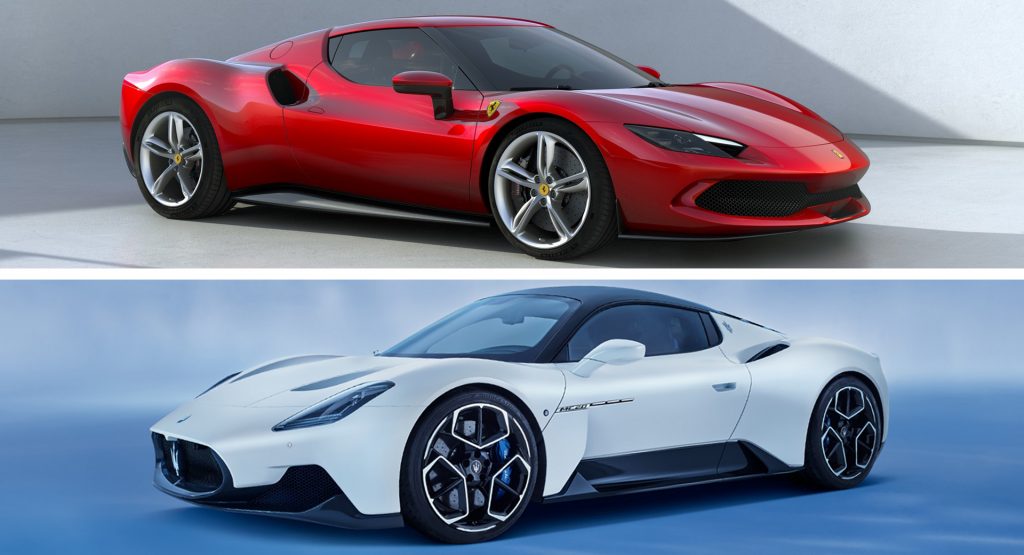Ferrari just unveiled their all-new 296 GTB hybrid, and while it is officially a brand-new car, it appears to have some things in common with the Maserati MC20. But just how similar are these two mid-engine, rear-wheel drive sports cars? Let’s take a closer look.
Powertrains
One of the biggest things for both of these cars is that they’re doing away with V8s in favor of a V6. Not just that, but both cars have a 3.0-liter twin-turbocharged V6 (Ferrari rounds their 2,992cc down to 2.9 liters), with the 296 GTB making 654 hp (663 PS / 488 kW), and the MC20 making 621 hp (630 PS / 463 kW). Those figures are quite similar, and had Maserati not made a point of claiming their engine was completely of their own design, that small difference could have theoretically been chalked up to just different tuning.
See Also: New Ferrari 296 GTB Brings Back V6 With A Turbocharged Hybrid Twist And 819-HP
However, unlike the MC20, the 296 GTB is a hybrid, and as such it has an electric motor boosting its output to 819 hp (830 PS / 611 kW). That being said, Maserati says they’re also working on an all-electric version of the MC20 that will “absolutely be more powerful“, so perhaps we could see the power gap between the two close once that arrives.
Exterior Styling
This is probably where the 296 GTB and MC20 differ the most. Aside from the styling elements necessary for a mid-engine car like a cab-forward design and rear fender intakes, the only thing they seem to have in common is their upward-kinking window lines, and even those are still slightly different. Overall, while not Lamborghini-sharp, the 296 GTB is a bit less curvy than the MC20, but its fenders are more pronounced and only accentuated by its more upright placement of the rear intake.
Read More: Maserati MC20 Debuts With 621 HP Twin-Turbo V6 And EV Option, Starts At $210,000
Both cars feature a sort of “framed-off” rear end, and both manage to incorporate their signature taillights in new ways. The Maserati has two exhaust tips and its diffuser area continues all the way up the bumper, while the Ferrari has a single center exhaust and keeps the diffuser separate of the bumper, creating a slightly less sporty, but much more elegant rear.
Out front, both cars show their respective brand identities quite well. The Maserati has its signature grille, and while the Ferrari looks a little different than some Prancing Horses of the past, it’s clear that it’s an interpretation of their new design language first seen on cars like the SF90 Stradale and the Roma.
Interior Design
Watch: Maserati MC20 Heads To Ferrari’s Fiorano Racetrack For More Testing
Inside, the design of each is noticeably different, but their layouts are very similar, with both featuring a long horizontal dash visually disconnected from a thin center tunnel. The Ferrari’s is more driver focused, going so far as removing the infotainment screen, but it’s also more elegant with flowing lines and supple leather surfacing. The Maserati, on the other hand, appears a bit sportier with its no-frills design and ample use of carbon fiber.
Market Positioning
Both cars are powerful, Italian mid-engined supercars — but that’s about where the similarities end. Due to their different brand philosophies and market segments, the halo car from Maserati starts at $210,000, which isn’t cheap, but the 296 GTB, which still has some cars sitting above it in Ferrari’s lineup, will cost around $321,000.
Overall, the Ferrari seems to be not only more powerful, but the more elegant of the pair as well, and while on paper they might have some similarities, like using twin-turbo V6s and being rear-wheel drive, in the end they belong to different segments and, thus, target different customers.
Which one will prove to be the most thrilling to drive? Well, spec sheets can’t tell you that, can they? Guess we’ll have to wait a little longer to find out.











